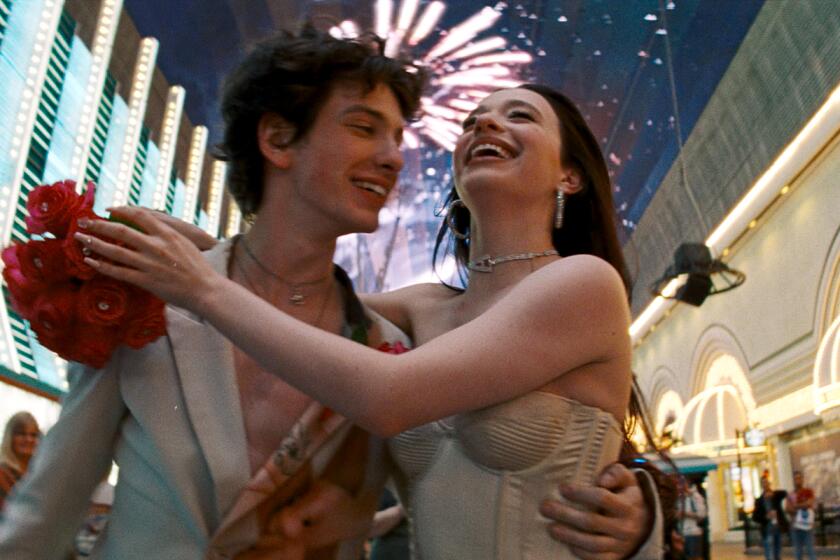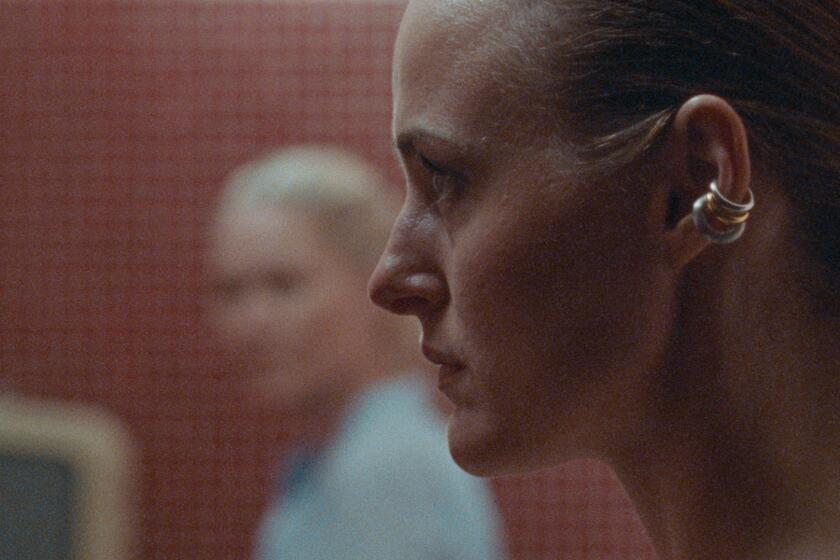Byting Edge of Visuals : Technology: A La Jollan’s latest effort to promote computer animation, opening Friday at the Reuben H. Fleet, is a fast-paced package designed to push viewers back in their seats.
- Share via
SAN DIEGO — The radio promotions for Steven Churchill’s new festival of computer animation sound like ads for a high-tech rock concert.
“ ‘Future Visions’ will take you to the edge of technology,” the breathless announcer says in an oddly mechanical voice, describing the festival opening Friday at the Reuben H. Fleet Space Theater.
In his La Jolla Colony home, Churchill stopped the tape of the radio ad, obviously happy with the high-energy effect.
“The thing that is pleasing about these (computer) presentations is that a lot of money is spent on (animation pieces), typically for advertising purposes,” Churchill said. “This makes for the opportunity to appreciate the animation more.”
The festival represents Churchill’s latest effort to advance the fledgling art form. The 35-year-old San Diegan has made a career out of presenting computer animation, perhaps best exemplified by “The Mind’s Eye,” the best-selling video compilation of state-of-the-art computer animation he put together for Miramar productions in 1990.
Now he is teaming up with the Fleet in Balboa Park in a move that both Churchill and Fleet management hope will bring a new audience to the theater.
“Future Visions: The Computer Animation Festival,” the Fleet’s first foray into computer animation, is a fast-paced package designed to astound viewers and push them back in their seats. It doesn’t spotlight clips of animation done for commercials or the effects seen in movies like “Terminator II” and “Death Becomes Her.” The segments are from the hinterland of computers, images and scenes completely generated by the machines and the operator’s imaginations, ranging from a realistic three-dimensional forest to a surreal fantasy land of exploding colors.
The different creations, representing a variety of animators, are brought together and integrated--with the help of a computerized editing system, of course--to produce a seamless, continuous work powered by the music of Jan Hammer, the synthesizer wizard best known for his soundtracks to the “Miami Vice” television series.
While other entrepreneurs market packages of computer animation, Churchill, a former animator himself, and his company, Odyssey Visual Design, have managed to stand out by teaming the top work with upbeat new age music. His success also sets him apart from the competition.
His first compilation, “State of the Art of Computer Animation,” released in 1988 by Pacific Arts Video, won “Best Video Art” award from the American Film Institute. “The Mind’s Eye” spent 30 weeks on the Billboard charts of home video sales, rising as high as No. 14.
“Steve has done an admirable job of publishing some of the best examples of computer animation; he’s been real discriminating,” said Michael Gosney, publisher and editor of Verbum, a San Diego-based national magazine dedicated to “personal computer aesthetics.”
Gosney says Churchill shares his own desire to promote the “higher creative vision” of computer animators, the idea that it is an art form beyond the well-known commercial applications.
“Mostly the masses think of computer animation as the spinning logos they see on television,” Gosney said. “Those of us deeply involved in making real art with these tools are interested in sharing the heartfelt work many of these artists do.”
The names of the producers of the segments of the “Future Visions” collection may not be well known to the general public, but they are the hot shots of the field: Karl Sims, Yoichiro Kawaguchi and Matt Elson, as well as companies such as Industrial Light and Magic, Pacific Data Images, Rhythm & Hues and Links Corp. Animated sequences from the recent movie “The Lawnmower Man,” created by the Carlsbad-based Angel Studios, are also included.
For the Space Theater, the computer animation festival is viewed as something of an experiment.
Because the presentation is on video, and not in the big-screen Omnimax format, the visual image won’t fill the dome in the same manner as the regular Space Theater fare. But a new high-tech projection system designed by Faroudja Laboratories, which practically doubles the resolution, producing an extremely crisp and clean image, is being used to maximize the impact.
“It wasn’t possible technically three or four years ago to present an image the size that would work in the space theater,” said Joseph Deken, senior scientist for the space center and a senior fellow at the San Diego Supercomputer Center, a research center based on the UCSD campus.
In recent years, the Space Theater has been toying with different entertainment in the space theater, including rock ‘n’ roll laser shows. Omnimax films are expensive to produce, and the Space Theater is constantly looking for new programs. Deken helped establish Project Oasis, a 2-month-old effort at the Space Center to work with computer animators and other research scientists.
Space Theater officials view computer animation as a way to present something different. It also fits the center’s goal of bringing science to the masses in ways they can experience firsthand.
The Space Theater setting also works for Churchill, who is anxious to expose more people to the art of computer animation in different settings. He says the theater’s sound system is “probably the best in the county.”
Churchill’s concern for the manner of presenting the work stems from his own background as an animator. He studied animation, motion picture special effects and experimental film at the UC Santa Barbara before dropping out to work for a company specializing in state-of-the-art animation.
“The company was on the cutting edge; it was a really good education,” Churchill said. “I couldn’t learn it at school because it didn’t exist in school.”
In 1982, Churchill moved to San Diego to start Odyssey, specializing in creating animation and graphics for advertising and promotions. His list of clients included several local radio and television stations, Union Oil, General Dynamics, Coca Cola and Honda. He had three employees working for him and seemed to be establishing a name for himself.
In 1986 and ’87 he staged festivals of computer animation at the Museum of Contemporary Art in La Jolla, primarily as a way to promote his business, as well as the industry. That led directly to the “State of the Art of Computer Animation” video, which started him on a new path.
Buoyed by the success of “State of the Art” and the subsequent “The Mind’s Eye,” Churchill decided to devote all his energies to putting together and marketing the video packages. The demands of keeping up with the latest technology and the hassles of maintaining a competitive graphics business made it an easy choice.
“I miss it from the standpoint of creating personal art, but I don’t from a business end,” he said.
Of course, there are creative aspects to producing the tapes. He specializes in melding the various work together, and takes particular pride in developing the correct musical accompaniment and synchronizing it to the images.
Churchill’s challenge is also to stay abreast of what is happening in the fast-paced industry. What was state of the art two years ago is now ancient history.
Even from the time of “Mind’s Eye” in 1990 to “Beyond the Mind’s Eye,” which won’t be officially released until Oct. 9, there have been noticeable advances, Churchill said.
“You can actually see the progress in the image quality and the level of complexity,” Churchill said. “There is more sophistication, from the most realistic scenes to the most fantastic scenes.”
The artistic elements have grown stronger simply because more people are working in the medium, primarily the equipment has gotten cheaper, providing more access to more people. For example, software that allows a form of “morphing,” the ultra-cool effect that allows one image to seamlessly evolve into another, best known from “Terminator II” and one of Michael Jackson’s recent videos, can be purchased by the home PC user for a couple of hundred dollars.
“As more and more people are able to use the technology, more imaginations are using the tools to come up with new ideas,” Churchill said. “They are such exciting and intense images. You can create your own world.”
The question is really whether the form will move beyond the realm of “neat” and be valued as true art, appreciated outside the world of advertising and promotion. Churchill believes that is already happening.
“It already is being used by people for personal expression,” Churchill said. “It is there now, it will just take time for people to perceive it as such.”
* “Future Visions: The Computer Animation Film Festival,” screens Sept. 18-20 and Sept. 25-27 at 5, 7 and 9 p.m. on Fridays; Saturdays at 3, 5, 7 and 9 p.m.; and Sundays at 5 and 7 p.m. Admission is $8 per person, with children under 5 admitted free. Contact 238-1233 for more information.
More to Read
Only good movies
Get the Indie Focus newsletter, Mark Olsen's weekly guide to the world of cinema.
You may occasionally receive promotional content from the Los Angeles Times.







